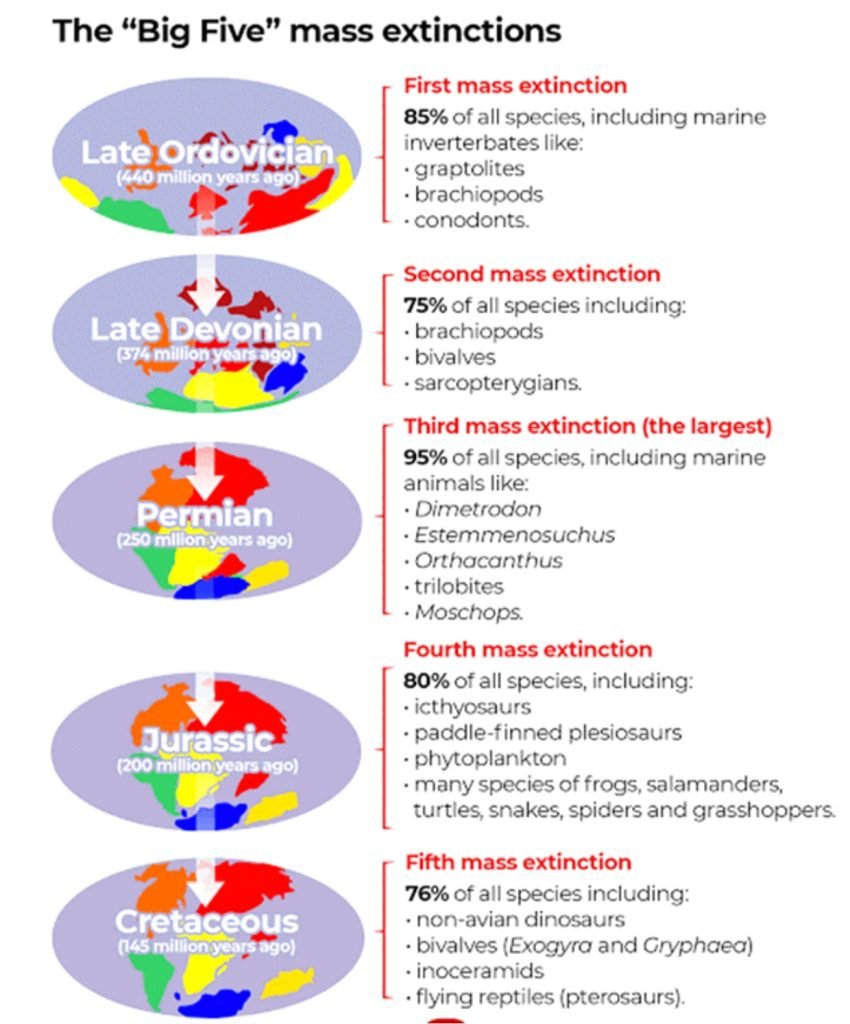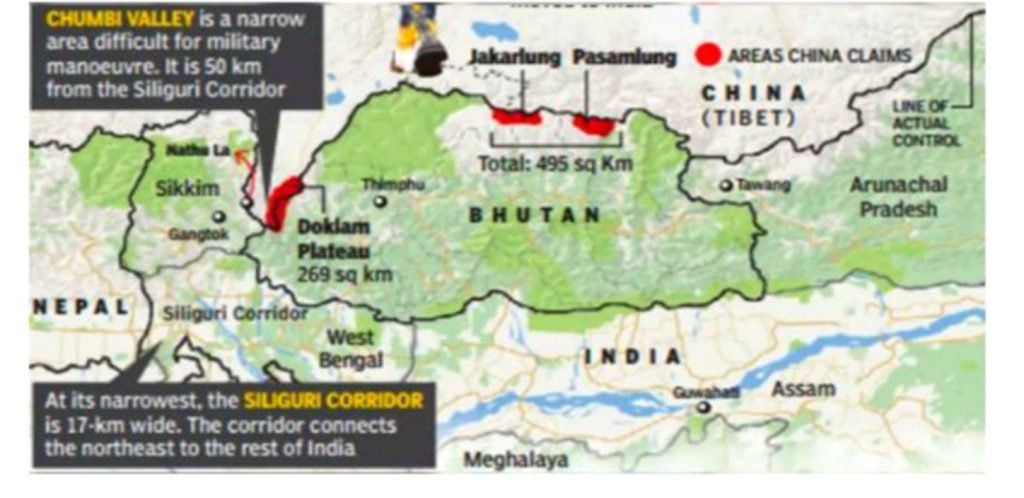Earth’s First Mass Extinction
Indian Express
GS 3: Environment and Conservation
Context:
- A paper published last week in the journal, Nature Geoscience, has come up with a new reason behind the first mass extinction, also known as the Late Ordovician mass extinction.

About:
- Before the Cretaceous mass extinction which wiped out non-avian dinosaurs, the Earth had witnessed four other great mass extinctions.
- Cooling climate likely changed the ocean circulation pattern. This caused a disruption in the flow of oxygen-rich water from the shallow seas to deeper oceans, leading to a mass extinction of marine creatures.
- The Ordovician mass extinction that occurred about 445 million years ago killed about 85% of all species. The other big extinction events were:
- The Devonian mass extinction (about 375 million years ago) wiped out about 75% of the world’s species.
- The Permian mass extinction (about 250 million years ago) also known as the Great Dying caused the extinction of over 95% of all species.
- The Triassic mass extinction (200 million years ago) eliminated about 80% of Earth’s species, including some dinosaurs.
- Now, humans are currently experiencing a sixth mass extinction as the result of human-induced climate change.
- Global warming causes the oceans to lose oxygen and thus impact marine habitability, potentially destabilising the entire ecosystem.
- In recent years, mounting evidence points to several episodes in the Earth’s history when oxygen levels also dropped in cooling climates.
- Computer modelling simulations suggested that climate cooling was likely responsible for the Late Ordovician mass extinction. They also noticed a lack of oxygen or anoxia in deep oceans during the period.
- Climate cooling may have led to changes in nutrient cycling, primary producer communities which ultimately drove the Late Ordovician mass extinction.
Highest Power Shortage
The Hindu
GS 3: Economy
Context:
- India recorded a power supply shortage of 1,201 million units in October 2021.
About:
- The power supply constraint is the worst in 5.5 years as a result of a scarcity of coal inventories at thermal units.
- At the same time, power demand had increased by more than 24%.
- The shortage was mostly restricted to Gujarat, Haryana, Jharkhand, Punjab and Rajasthan.
- In October, Gujarat recorded a power shortage of 215 million units, the highest for any month in more than a decade. With a shortage of 77 million units, Jharkhand too recorded its highest deficit in more than a decade.
- Supply shortage was also observed in Uttar Pradesh and the Union Territory of Jammu and Kashmir in October, however, they were not an anomaly but were similar to the general trend observed in the regions.
- The power shortage was primarily due to a supply crunch of coal to 135 thermal plants. As on November 5, the average coal inventory held by the plants would last only seven days.
- Historical data were compiled from the Central Electricity Authority, and October 2021 data were compiled from day-wise reports available with the National Load Despatch Centre (NLDC) under the Ministry of Power.

Coal in India:
- Coal accounts for 70% of the country’s electricity generation.
- The ash level in Indian coal is high while the sulphur concentration is low.
- It may be categorised into three varieties based on its carbon content:
- Anthracite: It is the coal with 80 to 95% carbon content found in small quantities in Jammu and Kashmir.
- Bituminous: It has a 60 to 80% carbon content and is found in Jharkhand, West Bengal, Odisha, Chhattisgarh and Madhya Pradesh.
- Lignite carries 40 to 55% carbon content and is found in Rajasthan, Lakhimpur (Assam) and Tamil Nadu.
- Peat is a coal with low calorific value and less than 40% carbon content.
India’s Climate Promises
The Indian Express
GS 3: Environment and Conservation
Context:
- At the UN climate conference in Glasgow, PM raised India’s existing climate targets, and also announced a few new targets.
Net-zero
- Of the five-point targets announced by PM, achieving net-zero emission status by 2070 is the one whose roadmap is not available right now. This promise seems to have been made primarily to satisfy the international demand.
- At the same time, 2070 is a long way away — and there is plenty of time to plan a roadmap to achieve that target.
- The other four targets have to be achieved in a more immediate timeframe, by 2030.
Emission intensity, renewables:
- Two of the targets — reducing emissions intensity and increasing the renewable mix in installed electricity capacity — are already part of India’s official Nationally Determined Contributions or NDCs, submitted in 2015 as part of the requirement under the Paris Agreement.
- In that NDC, India had promised to reduce its ‘emissions intensity’, or emissions per unit of GDP, by 33-35% from 2005 levels by 2030, and to ensure that at least 40% of its installed electrical capacity in 2030 would come through non fossil-fuel-based energy sources.
- PM has now enhanced both these targets: emissions intensity reduction to 45%, and the share of renewables in installed electricity capacity to 50%.
- India was already on course to achieve both these existing targets well before the 2030 deadline. India’s emissions intensity was 24% below 2005 levels in 2016 itself, the latest year for which data are available.
- A 33-35% reduction is expected to be achieved within the next two years. Although initial reductions are easier to achieve than later ones, a 45% reduction is not expected to pose too much of a challenge.
Forest cover: Not addressed
- The third promise made in India’s NDC, about increase in forest cover, did not find a mention in PM’s speech. And that is the only target India is struggling to achieve.
- In the NDC, India has promised to create an additional carbon sink of 2.5-3 billion tonnes of carbon dioxide equivalent through forest and tree cover by 2030.
- Although forest cover has been growing, according to official data, the pace of growth so far has been far from commensurate with what is required to meet the target.
Non-fossil fuel
- PM’s other two announcements, about raising installed capacity of renewable energy, and an absolute reduction of 1 billion tonnes of carbon dioxide by 2030, are not part of India’s existing commitments, but are nonetheless linked.
Absolute emissions
- India would ensure it reduces 1 billion tonnes from its projected emissions between now and 2030. Put another way, India would bend its business-as-usual emissions trajectory to ensure at least 1 billion tonnes of emissions are saved.
- This is the first time India has talked about making a reduction in its absolute emissions. All previous formulations used to be in terms of emission intensity, which is emissions per unit of GDP.
- The promise to reduce 1 billion tonnes of emissions could, therefore, be another way of reiterating the emission intensity target.
Technical Textiles
The Hindu
GS 3: Growth and Development
Context:
- Recently, the Textile minister said the government will support production-linked incentives (PLIs) for the textile sector in states supporting the development and offering affordable infrastructure for textile manufacturing like cheap land and power.
About:
- A technical textile is a textile product manufactured for non-aesthetic purposes, where function is the primary criterion.
- Technical textiles include textiles for automotive applications, medical textiles, geotextiles, agrotextiles, and protective clothing.

Government efforts in this regard:
- In January 2019, the government issued 207 HSN Codes for technical textiles and in less than two years, India had become a net exporter of technical textiles.
- It also unveiled the National Technical Textiles Mission in February last year.
- As many as 92 technical textile items have been made mandatory for use by government organisations covering agriculture, horticulture, highways, railways, water resources, and medical applications.
China active now at Chumbi Valley
The Hindu
GS 2: International Relations
Context:
- China is strengthening its connectivity and increasing its depth in the Chumbi Valley, close to India’s strategic and vulnerable Siliguri corridor.
About:
- According to the US Department of Defence, despite diplomatic and military dialogues to reduce border tensions, the PRC has “continued taking incremental and tactical actions to press its claims at the Line of Actual Control.”
- China is building an alternative axis in the Chumbi Valley. They are increasing their depth by building roads through Bhutanese territory.
- According to the report, Beijing, asserting that its deployments close to the LAC were in response to Indian provocation, had refused to withdraw any forces until India’s forces withdrew behind the PRC’s version of the LAC and ceased infrastructure improvements in the area.
Chinese Incursion:
- Chumbi valley is close to India’s strategic and vulnerable Siliguri corridor, also called Chicken’s Neck.
- The area was recently termed “sensitive” by General Officer Commanding-in-Chief, Eastern Army Command.
- Satellite images that came out last year had shown China building roads along the Torsa river area through Bhutanese territory.
- In this context, the recent MoU on a three-step road map between Bhutan and China to speed up their talks for boundary resolution was significant and could have implications for India.
- Sometime in 2020, the PRC built a large 100-home civilian village inside disputed territory between the PRC’s Tibet Autonomous Region and India’s Arunachal Pradesh state in the eastern sector of the LAC.
- The People’s Liberation Army (PLA) had conducted a month-long recruitment drive in Chumbi valley of around 400 Tibetan persons in August 2021.
Way Forward:
- Not only the security forces, the military and certain other Central Armed Police Forces (CAPF), but also the Governments of the States around the Siliguri corridor and Central agencies were all working together in a coordinated manner to “mitigate this threat in normal times, the hybrid threat as and when it manifests as also during conflict conditions.
- A joint coordinating centre under the Army to be effective to coordinate actions of all agencies that work there.
- At the national level, there was a thought process to look at alternative means in terms of economic activities, etc., to mitigate this threat to the Siliguri corridor.


